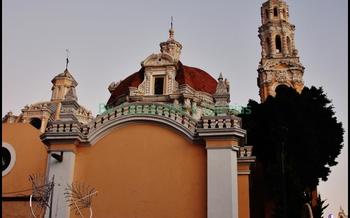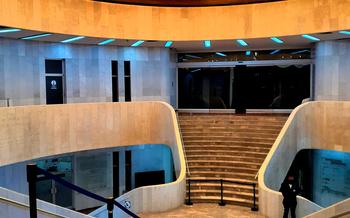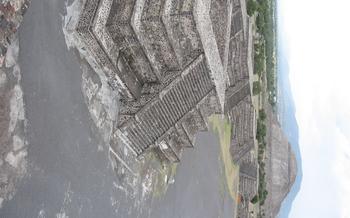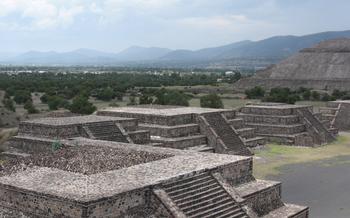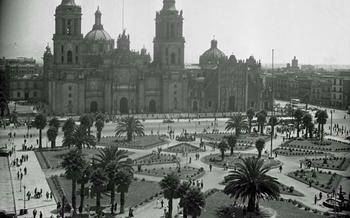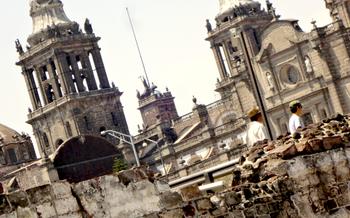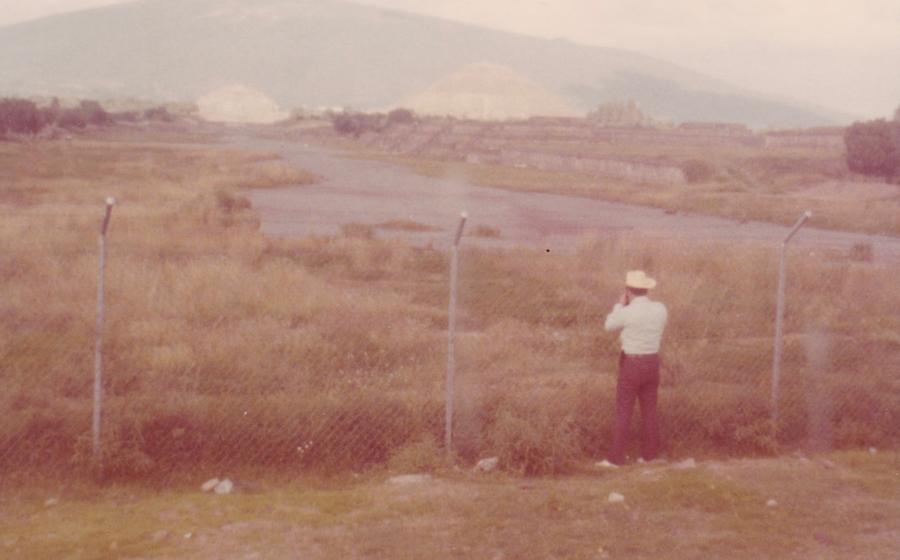
Museo Dolores Olmedo
- The Museo Dolores Olmedo in Teotihuacan: A Journey into Mexican Art and Culture
- Discovering Frida Kahlo's Legacy: A Masterful Exhibition
- Diego Rivera's Murals: A Monumental Showcase of Mexican History
- Angelina Beloff: Unveiling the Forgotten Master
- Navigating the Museum's Collections: A Guide for Visitors
- Immerse Yourself in Mexican Traditions: Traditional Art and Dance Performances
- Step into Frida Kahlo's World: The Xochimilco Gardens
- Beyond the Museum: Exploring Teotihuacan's Ancient Wonders
- Savoring Authentic Mexican Cuisine: The Museum's Restaurant
- Shopping for Unique Souvenirs: The Museum's Gift Shop
- Accessibility and Facilities: Ensuring a Comfortable Visit
- Educational Programs and Workshops: Engaging with Mexican Art
- Volunteering and Supporting the Museum's Mission
- Capturing Memories: Photography and Social Media
- Insider Tip: Unveiling Hidden Gems
The Museo Dolores Olmedo in Teotihuacan: A Journey into Mexican Art and Culture
Nestled in the heart of Teotihuacan, the Museo Dolores Olmedo stands as a testament to the vibrancy and diversity of Mexican art and culture. Founded by Dolores Olmedo, a renowned art collector and philanthropist, the museum houses an extraordinary collection of masterpieces by some of Mexico's most celebrated artists, including Frida Kahlo, Diego Rivera, and Angelina Beloff.
Dolores Olmedo, driven by her passion for Mexican art and culture, dedicated her life to preserving and promoting the works of these talented artists. Through her tireless efforts, she amassed an impressive collection that now forms the cornerstone of the museum's exhibitions.
The museum's architectural design, a fusion of colonial and Mexican styles, reflects Olmedo's deep appreciation for her country's heritage. The striking facade, adorned with colorful tiles and intricate carvings, hints at the treasures that await visitors within.
Discovering Frida Kahlo's Legacy: A Masterful Exhibition
Frida Kahlo, an iconic figure in the world of art, left an indelible mark on Mexican culture and history. The Museo Dolores Olmedo houses an extensive collection of Kahlo's works, including paintings, drawings, and personal belongings, offering a profound insight into her life and artistic journey.
Immerse Yourself in Kahlo's World
Through her art, Frida Kahlo expressed her innermost thoughts, emotions, and experiences, often drawing inspiration from her own physical and emotional pain. Visitors to the museum can delve into her creative process and understand the complexities of her personal narrative through her powerful and poignant works.
Exploring the Collection
The museum's collection features some of Kahlo's most renowned paintings, such as "Self-Portrait with Thorn Necklace and Hummingbird" and "The Two Fridas," which offer a glimpse into her tumultuous relationship with Diego Rivera and her ongoing struggle with identity and self-expression. Her works are characterized by vibrant colors, surrealistic elements, and a unique blend of Mexican and European influences.
Unveiling Kahlo's Significance
Frida Kahlo's art transcended the boundaries of her personal experiences, becoming a powerful symbol of Mexican identity, resilience, and female empowerment. Her works have inspired generations of artists and continue to resonate with audiences worldwide, cementing her legacy as one of the most influential figures in Mexican art history.
Diego Rivera's Murals: A Monumental Showcase of Mexican History
Immerse yourself in the grandeur of Diego Rivera's murals, which adorn the walls of the Museo Dolores Olmedo. These monumental works of art depict key moments in Mexican history, from the ancient civilizations to the Mexican Revolution. Rivera's murals are not just artistic masterpieces; they are also powerful political statements, reflecting his socialist beliefs and his deep love for his country.
Analyzing Symbolism and Technique Rivera's murals are a treasure trove of symbolism, with every detail carefully chosen to convey a deeper meaning. His use of color is also significant, with vibrant hues representing the vibrancy and diversity of Mexican culture. In terms of technique, Rivera experimented with different styles, from traditional fresco painting to more modern approaches. His murals are characterized by their bold lines, dynamic compositions, and expressive figures.
Insights into Rivera's Worldview Through his murals, Rivera offers a unique perspective on Mexican history. He portrays the struggles and triumphs of the Mexican people, highlighting their resilience and their fight for social justice. Rivera's murals also shed light on his own political views, as he uses his art to promote socialism and criticize capitalism.
A Must-See for Art and History Enthusiasts Diego Rivera's murals are a must-see for anyone interested in Mexican art and history. They are a testament to Rivera's genius as an artist and his unwavering commitment to social change. As you stand before these monumental works, you will not only be awed by their beauty but also gain a deeper understanding of Mexico's rich and complex past.
Angelina Beloff: Unveiling the Forgotten Master
Amidst the celebrated works of Frida Kahlo and Diego Rivera, the Museo Dolores Olmedo houses a lesser-known treasure: the art of Angelina Beloff. This talented artist, born in Russia in 1879, played a significant role in the Mexican art scene during the early 20th century, yet her contributions have often been overshadowed by those of her more famous contemporaries.
Beloff's unique style, influenced by Russian Constructivism and Mexican folk art, set her apart from her peers. Her paintings and drawings often featured bold geometric forms, vibrant colors, and a strong sense of social consciousness. She was particularly drawn to the plight of the working class and the indigenous communities of Mexico, and her art often reflected their struggles and aspirations.
Despite her talent and dedication, Beloff's work was often overlooked during her lifetime. She faced discrimination as a woman and a foreigner, and her art was not widely recognized until after her death in 196Today, the Museo Dolores Olmedo is working to bring Beloff's legacy to light, showcasing her paintings, drawings, and personal belongings in a dedicated gallery.
By exploring Beloff's art, visitors to the museum gain a deeper understanding of the diverse and complex history of Mexican art. Beloff's work challenges traditional notions of beauty and aesthetics, pushing the boundaries of what was considered acceptable in her time. She was a true pioneer, and her contributions to Mexican art deserve to be celebrated and remembered.
Navigating the Museum's Collections: A Guide for Visitors
To make the most of your visit to the Museo Dolores Olmedo, it's essential to have a plan. Here's a guide to help you navigate the museum's collections and maximize your experience:
-
Museum Map: Obtain a map or layout of the museum at the entrance. This will help you visualize the different galleries and exhibits and plan your route accordingly.
-
Suggested Itineraries: If you're short on time, consider following one of the suggested itineraries provided by the museum. These itineraries are designed to showcase the highlights of the collection and ensure you don't miss any key pieces.
-
Optimal Times to Visit: To avoid crowds and ensure a more intimate experience, plan your visit during weekdays or early in the morning. The museum is typically busiest on weekends and holidays.
-
Guided Tours and Audio Guides: Enhance your museum experience by joining a guided tour or renting an audio guide. These options provide valuable insights into the artworks and the lives of the artists, allowing you to delve deeper into the museum's collection.
Immerse Yourself in Mexican Traditions: Traditional Art and Dance Performances
The Museo Dolores Olmedo offers a unique opportunity to immerse yourself in the vibrant traditions of Mexican culture through its regular events. Traditional dance performances, art workshops, and special exhibitions showcase the diverse expressions of Mexican heritage and artistry.
Traditional Dance Performances:
Every Sunday, the museum's courtyard comes alive with the rhythm and color of traditional Mexican dance performances. Talented dancers clad in elaborate costumes showcase the rich diversity of regional dances, from the energetic "Jarabe Tapatío" to the graceful "Son Jarocho." These performances offer a captivating glimpse into Mexico's rich cultural heritage and provide a memorable experience for visitors.
Art Workshops:
Throughout the year, the museum organizes art workshops that allow visitors to engage with Mexican art forms firsthand. Under the guidance of experienced instructors, participants can learn traditional techniques such as pottery, weaving, and paper mache. These workshops offer a hands-on opportunity to create unique souvenirs while gaining a deeper understanding of Mexican craftsmanship.
Special Exhibitions:
In addition to its permanent collection, the museum hosts special exhibitions that highlight specific aspects of Mexican art and culture. These exhibitions may focus on the works of renowned artists, historical periods, or contemporary trends. By showcasing a diverse range of artistic expressions, the museum provides a platform for emerging and established artists to share their work with the public.
Importance of These Events:
The museum's commitment to preserving and promoting Mexican culture is evident in its dedication to hosting these special events. Traditional dance performances, art workshops, and exhibitions play a crucial role in keeping Mexican traditions alive and accessible to both local and international visitors. By showcasing the diversity and richness of Mexican heritage, the museum contributes to the cultural identity and pride of the nation.
Step into Frida Kahlo's World: The Xochimilco Gardens
Beyond the walls of the Museo Dolores Olmedo lies a hidden gem, a sanctuary of natural beauty and artistic expression: the Xochimilco Gardens. Designed by Diego Rivera himself, these gardens pay homage to the rich cultural traditions of Mexico.
As you stroll through the lush greenery, you'll encounter a symphony of colors and textures, a testament to Rivera's deep appreciation for the natural world. Sculptures and fountains adorn the landscape, adding a playful touch to the already enchanting surroundings.
The gardens are named after the famous Xochimilco canals, a UNESCO World Heritage Site known for its colorful boats and vibrant atmosphere. Rivera's aim was to recreate the essence of Xochimilco within the confines of the museum, offering visitors a glimpse into this unique cultural heritage.
Take a moment to sit by the tranquil waters of the lily pond, surrounded by vibrant flowers and the gentle sound of birdsong. Let the beauty of nature wash away your worries as you soak in the serene atmosphere.
For a truly immersive experience, plan your visit during the spring when the gardens are in full bloom. The explosion of colors and fragrances will leave you breathless, creating memories that will last a lifetime.
Don't forget to bring your camera to capture the stunning vistas and hidden corners of this enchanting garden. Follow the winding paths, discover secret nooks, and let your imagination run wild as you explore Frida Kahlo's beloved Xochimilco Gardens.
Beyond the Museum: Exploring Teotihuacan's Ancient Wonders
Just a short distance from the Museo Dolores Olmedo lies the ancient city of Teotihuacan, a UNESCO World Heritage Site and one of Mexico's most impressive archaeological wonders. This sprawling metropolis, once home to over 100,000 people, flourished between 100 BC and 650 AD. Its well-preserved ruins, including the iconic Pyramids of the Sun and Moon, offer a glimpse into the sophisticated civilization that inhabited this region centuries ago.
To reach Teotihuacan from the museum, you can take a bus or taxi, or join a guided tour that includes transportation. Once there, you'll be greeted by a breathtaking panorama of towering pyramids, vast plazas, and intricate temples.
Start your exploration at the Pyramid of the Sun, the largest structure in Teotihuacan and one of the most massive pyramids in the world. Climb the steep steps to the summit for panoramic views of the entire archaeological site and the surrounding valley.
Next, head to the Pyramid of the Moon, which is slightly smaller but equally impressive. This pyramid is believed to have been dedicated to the moon goddess and was used for religious ceremonies.
Don't miss the Avenue of the Dead, the main thoroughfare of Teotihuacan that connects the Pyramid of the Sun with the Pyramid of the Moon. Along this 2-mile-long avenue, you'll find various temples, palaces, and residential complexes that once housed the city's elite.
As you explore Teotihuacan, pay attention to the intricate carvings and murals that adorn many of the buildings. These artworks provide valuable insights into the beliefs, customs, and daily life of the Teotihuacan people.
To make the most of your visit, consider hiring a guide who can share fascinating stories and historical context about this ancient city. Alternatively, you can download a self-guided audio tour or purchase a guidebook to enhance your exploration.
Whether you're a history buff, an architecture aficionado, or simply someone who appreciates the wonders of the ancient world, a visit to Teotihuacan is an unforgettable experience that will transport you back in time to one of Mexico's most awe-inspiring civilizations.
Savoring Authentic Mexican Cuisine: The Museum's Restaurant
Step into the heart of Mexican gastronomy at the Museo Dolores Olmedo's charming restaurant. The menu is a symphony of flavors, showcasing the diverse culinary traditions of Mexico. Savor the tantalizing aromas of freshly prepared dishes, crafted with love and a deep respect for local ingredients.
Indulge in the exquisite sopes, corn tortillas topped with a variety of savory fillings, such as beans, cheese, and shredded meats. Experience the richness of enchiladas, corn tortillas smothered in a flavorful sauce and filled with cheese, beans, or meats. Don't miss the tacos al pastor, a classic Mexican street food made with spit-roasted pork and served with fresh pineapple and cilantro.
Complement your meal with a refreshing glass of horchata, a sweet and creamy beverage made with rice milk and cinnamon, or sip on a traditional agua fresca, a refreshing fruit-based drink. For a truly authentic experience, try the pulque, a fermented beverage made from the sap of the maguey plant.
The restaurant's ambiance is rustic and inviting, with colorful tablecloths and traditional Mexican décor. Enjoy your meal in the shade of the lush garden, surrounded by the tranquil sounds of nature. The restaurant also features a cozy indoor dining area, perfect for cooler days or intimate gatherings.
Whether you're looking for a quick bite or a leisurely meal, the Museo Dolores Olmedo's restaurant is a must-visit destination for anyone seeking an authentic Mexican culinary experience. Prices are reasonable, and the friendly staff is always ready to recommend dishes and answer any questions.
Insider Tip: Be sure to try the mole poblano, a complex and flavorful sauce made with a variety of spices, nuts, and chocolate. This regional specialty is a true testament to the culinary prowess of Mexican cuisine.
Shopping for Unique Souvenirs: The Museum's Gift Shop
The Museo Dolores Olmedo's gift shop is a delightful haven for art enthusiasts and souvenir seekers alike. As you step inside, you'll be greeted by a vibrant array of colorful handicrafts, books, prints, pottery, and jewelry, all carefully curated to reflect the rich cultural heritage of Mexico.
Among the must-have items are intricately painted ceramics, featuring traditional Mexican motifs and vibrant hues. These handcrafted pieces make for beautiful home décor or thoughtful gifts for loved ones back home.
For those with a passion for Mexican history and art, the gift shop offers a treasure trove of books and prints. From in-depth biographies of Frida Kahlo and Diego Rivera to stunning reproductions of their iconic artworks, these publications provide a deeper understanding of Mexican art and culture.
Jewelry enthusiasts will delight in the selection of handcrafted silver and gemstone pieces, inspired by pre-Columbian designs and contemporary Mexican aesthetics. These unique creations add a touch of Mexican flair to any outfit.
By purchasing souvenirs from the museum's gift shop, you not only take home a piece of Mexican art but also support local artisans and the museum's mission to preserve and promote Mexican culture. So, take your time browsing the shelves, and discover the perfect memento of your visit to the Museo Dolores Olmedo.
Accessibility and Facilities: Ensuring a Comfortable Visit
The Museo Dolores Olmedo is committed to providing an inclusive and accessible experience for all visitors. The museum is wheelchair accessible, with ramps and elevators connecting all levels of the building. Accessible restrooms are also available for the convenience of visitors with disabilities.
To ensure a comfortable and enjoyable visit, the museum offers a variety of facilities and services. Lockers are available for visitors to store their belongings while exploring the museum. A café is also located on-site, providing a relaxing space to enjoy a refreshing beverage or a light snack.
For visitors with disabilities or special needs, the museum staff is available to provide assistance and ensure a smooth and enjoyable experience. Visitors are encouraged to contact the museum in advance to discuss any specific needs or requirements they may have.
By providing accessible features and facilities, the Museo Dolores Olmedo strives to create an inclusive environment where everyone can appreciate and engage with Mexican art and culture.
Educational Programs and Workshops: Engaging with Mexican Art
The Museo Dolores Olmedo offers a diverse range of educational programs and workshops designed to engage visitors of all ages with Mexican art and culture. These programs provide hands-on experiences and learning opportunities that deepen the understanding and appreciation of Mexico's rich artistic traditions.
One of the most popular workshops is the painting class, where participants can create their own artworks inspired by the styles and techniques of Mexican masters like Frida Kahlo and Diego Rivera. Guided tours are also available, led by knowledgeable docents who share insights into the museum's collection and the history of Mexican art.
For those interested in delving deeper into specific topics, the museum organizes art history lectures and seminars. These sessions cover various aspects of Mexican art, including its evolução, symbolism, and social and political influences.
To participate in these educational programs, visitors can check the museum's website or inquire at the information desk. Fees may apply for some workshops and lectures, but there are often discounted rates for students and seniors.
Volunteering and Supporting the Museum's Mission
The Museo Dolores Olmedo invites visitors to become active participants in preserving and promoting Mexican art and culture through volunteering and donation opportunities. Volunteering at the museum offers a unique chance to contribute directly to its mission while gaining valuable experience in the art world. Whether you are passionate about art history, education, or community engagement, there is a volunteer role that matches your interests and skills. From leading guided tours and assisting with educational workshops to assisting with conservation efforts and event planning, the museum provides a variety of opportunities for volunteers to make a meaningful impact. By joining the museum's dedicated team of volunteers, you will not only contribute to the preservation and promotion of Mexican art but also become part of a vibrant community of art enthusiasts. Additionally, the museum welcomes donations from individuals and organizations to support its ongoing initiatives, educational programs, and conservation efforts. Your generous contributions will help ensure the museum's continued success in showcasing and preserving Mexico's rich cultural heritage for generations to come.
Capturing Memories: Photography and Social Media
The Museo Dolores Olmedo is a treasure trove of Mexican art and culture, and visitors are encouraged to capture and share their experiences through photography and social media. The museum welcomes photography for personal use, but it is important to be respectful of the artwork and other visitors. Flash photography and tripods are not permitted, and visitors are asked to refrain from taking photos of other visitors without their permission.
To enhance your social media experience, use the designated hashtags #MuseoDoloresOlmedo, #FridaKahlo, #DiegoRivera, and #AngelinaBeloff to connect with other visitors and share your favorite moments. Get creative with your photography by experimenting with different angles, compositions, and lighting. Capture the essence of the museum's unique architecture, the vibrant colors of the artwork, and the serene beauty of the Xochimilco Gardens.
Don't forget to tag the museum's social media accounts (@MuseoDoloresOlmedo) in your posts to share your photos and experiences with the museum community. Your photos and stories help promote the museum's mission of preserving and sharing Mexican art and culture with the world.
Insider Tip: Unveiling Hidden Gems
Beyond the main galleries and exhibits, the Museo Dolores Olmedo holds a hidden gem that often goes unnoticed by visitors. Tucked away in a secluded corner of the museum, you'll find a small but captivating display dedicated to the life and work of Mexican artist Rodolfo Morales.
Morales, a contemporary of Frida Kahlo and Diego Rivera, was known for his surrealist paintings and his unique style that blended Mexican folk art with European modernism. The museum's collection includes several of Morales's lesser-known works, offering a glimpse into the artist's creative process and his contributions to the Mexican art scene.
To discover this hidden gem, simply ask a museum staff member to direct you to the Rodolfo Morales Gallery. Once there, take your time to admire Morales's colorful and imaginative paintings, which often depict fantastical creatures, mythical scenes, and dreamlike landscapes.
By exploring this hidden gem, you'll gain a deeper appreciation for the diversity and richness of Mexican art, and discover the works of a talented artist who deserves wider recognition.


